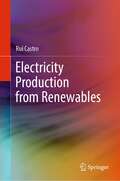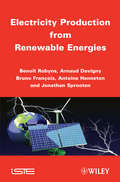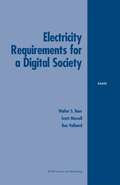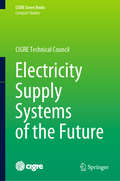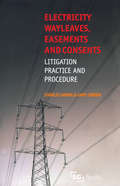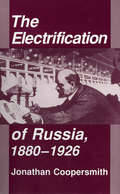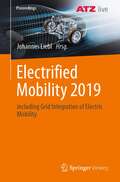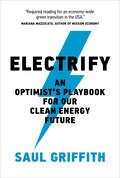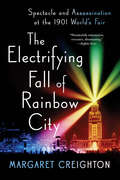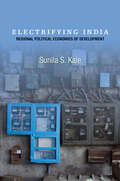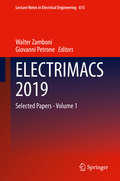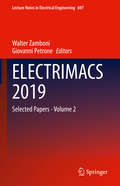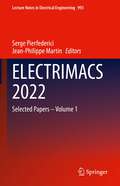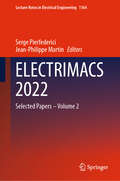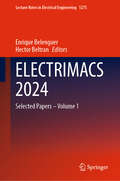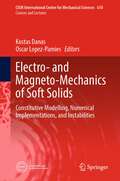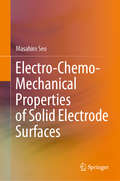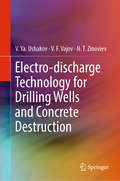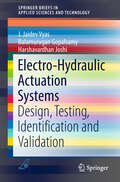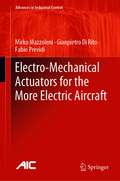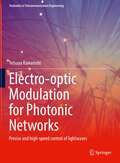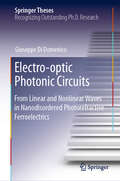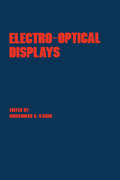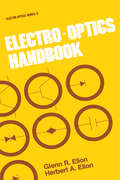- Table View
- List View
Electricity Production from Renewables
by Rui CastroThis textbook is about economically competitive renewable energy sources (RES), including onshore and offshore wind, solar and small-hydro plants, and focusing on the electricity production from these sources. Clearly divided into sections discussing the different RES, the textbook begins with an introduction of AC electrical circuits, aimed at non-electrical engineers. It then offers an economic assessment of renewable energy projects, before discussing photovoltaic technologies and concentrated solar power. It explores the theory of wind to power conversion, electrical generator types and electrical part of offshore systems. Presenting theoretical concepts related to the electrical framework associated with RES, alongside examples and solved problems, this book will clearly introduce the topic of renewable power sources to graduate students, researchers and practitioners alike. After reading the book, readers will be equipped to make a preliminary techno-economic assessment of a RES.
Electricity Production from Renewables Energies
by Jonathan Sprooten Arnaud Davigny Benoît Robyns Antoine Henneton Bruno FrançoisEnergy and environmental issues have caused a marked increase in electricity production from renewable energy sources since the beginning of the 21st Century. The concept of sustainable development and concern for future generations challenge us every day to produce new technologies for energy production, and new patterns of use for these energies. Their rapid emergence can make the understanding and therefore the perception of these new technologies difficult. This book aims to contribute to a better understanding of the new electricity generation technologies by addressing a diverse audience. It presents the issues, sources and means of conversion into electricity using a general approach and develops scientific concepts to understand their main technical characteristics.Systems of electricity generation from renewable energy resources of small to medium powers are presented. The basic electrical concepts necessary for understanding the operating characteristics of these energy converters are introduced, and the constraints and problems of integration in the electrical networks of those means of production are discussed. Several exercises are provided to the reader for evaluation purposes.Contents1. Decentralized Electricity Production from Renewable Energy, Benoît Robyns.2. Solar Photovoltaic Power, Arnaud Davigny.3. Wind Power, Bruno Francois and Benoît Robyns.4. Terrestrial and Marine Hydroelectricity: Waves and Tides, Benoît Robyns and Antoine Henneton.5. Thermal Power Generation, Jonathan Sprooten.6. Integration of the Decentralized Production into the Electrical Network, Benoît Robyns.
Electricity Requirements for a Digital Society
by Ben A. Vollaard Walter S. Baer Scott HassellGreater use of information and communications technologies (ICTs) marks a U.S. transition toward a "digital society" that may profoundly affect electricity supply, demand, and delivery. RAND developed four 2001-2021 scenarios of ICT evolution and assessed their implications for U.S. electricity requirements. Even large deployment of ICTs will only modestly increase U.S. electricity use over the next two decades. The more pressing concern will be how to meet the increased need for higher-quality and more-reliable power that accompanies ICT use.
Electricity Supply Systems of the Future (CIGRE Green Books)
by Nikos Hatziargyriou Iony Patriota de SiqueiraThis book offers a vision of the future of electricity supply systems and CIGRE’s views on the know-how that will be needed to manage the transition toward them. A variety of factors are driving a transition of electricity supply systems to new supply models, in particular the increasing use of renewable sources, environmental factors and developments in ICT technologies. These factors suggest that there are two possible models for power network development, and that those models are not necessarily exclusive: 1. An increasing importance of large networks for bulk transmission capable of interconnecting load regions and large centralized renewable generation resources, including offshore and of providing more interconnections between the various countries and energy markets. 2. An emergence of clusters of small, largely self-contained distribution networks, which include decentralized local generation, energy storage and active customer participation, intelligently managed so that they operate as active networks providing local active and reactive support. The electricity supply systems of the future will likely include a combination of the above two models, since additional bulk connections and active distribution networks are needed in order to reach ambitious environmental, economic and security-reliability targets. This concise yet comprehensive reference resource on technological developments for future electrical systems has been written and reviewed by experts and the Chairs of the sixteen Study Committees that form the Technical Council of CIGRE.
Electricity Wayleaves, Easements and Consents
by Charles Hamer Gary O'Brien'Wayleave' is an archaic term from the nineteenth century defined as 'a privilege enabling a person to cross another person’s land with infrastructure and with goods and chattels'. It has been applied to electricity rights because of the need to string electricity lines across land. Electricity is such a fundamental part of life that its supply is often taken for granted. In reality, the rights for electricity lines are arguably the weakest of all utilities, with the vast majority covered by wayleaves. Privatisation in the 1990s provided the opportunity to bolster wayleave rights, but it only led to a tinkering through primary legislation. The acceleration of telecommunications over the past twenty years has confused issues, with operators installing masts and adding apparatus to electricity lines. A large proportion of wayleaves are dealt with at local level, with little consistency. Coupled to this is the public concern that electricity lines have potentially serious health effects that continue to attract research and media interest. This book has been written for those involved in, or advising on, the use and development of land for transmission and distribution lines. As most people have only brief encounters with the electricity infrastructure, this guide will help to avoid the fear of the unknown. By setting out the main principles and procedures used and the relevant primary and secondary legislation in a clear and easy-to-follow way it will enable lawyers, surveyors, planners, architects, engineers and accountants to discuss the relevant issues with confidence.
The Electrification of Russia, 1880–1926
by Jonathan CoopersmithThe Electrification of Russia, 1880–1926 is the first full account of the widespread adoption of electricity in Russia, from the beginning in the 1880s to its early years as a state technology under Soviet rule. Jonathan Coopersmith has mined the archives for both the tsarist and the Soviet periods to examine a crucial element in the modernization of Russia. Coopersmith shows how the Communist Party forged an alliance with engineers to harness the socially transformative power of this science-based enterprise. A centralized plan of electrification triumphed, to the benefit of the Communist Party and the detriment of local governments and the electrical engineers. Coopersmith’s narrative of how this came to be elucidates the deep-seated and chronic conflict between the utopianism of Soviet ideology and the reality of Soviet politics and economics.
Electrified Mobility 2019: including Grid Integration of Electric Mobility (Proceedings)
by Johannes LieblDie inhaltlichen Schwerpunkte des Tagungsbands zu den ATZlive-Veranstaltungen Grid Integration of Electric Mobility und Electrified Mobility 2019 sind u.a. folgende Fragen: Wann können Stromnetze volatile Wind- und Solarenergie speichern? Wie sind die Stromübertragungsnetze ausgelegt? Können Spitzenlastsituationen abgedeckt werden? Die Tagung ist eine unverzichtbare Plattform für den Wissens- und Gedankenaustausch von Forschern und Entwicklern aller Unternehmen und Institutionen, die Antworten auf diese Fragen suchen.Der InhaltMobilität: Kundenfreundliche, vernetzte und intermodale Systeme.- Fahrzeuge und Antriebe: Klima- und emissionsneutrale Technik.- Energiespeicher: Batterien und Wasserstoff im neuen Antriebsportfolio.Die ZielgruppenFührungskräfte und Ingenieure bei Automobilherstellern, Zulieferern, Entwicklungsdienstleister - Forschungseinrichtungen und Hochschulen - Mitarbeiter bei Telekommunikationsdiensten, IT-Unternehmen, Energieversorgern und Netzbetreibern - Alle Einrichtungen, die sich mit Elektromobilität beschäftigenDer VeranstalterATZlive steht für Spitzenqualität, hohes Niveau in Sachen Fachinformation und ist Bestandteil der Springer Fachmedien Wiesbaden GmbH, ein Teil von Springer Nature. Hier wird unter einem Dach das Know-how der renommiertesten Wirtschafts-, Wissenschafts- und Technikverlage Deutschlands vereint.
Electrify: An Optimist's Playbook for Our Clean Energy Future
by Saul GriffithAn optimistic--but realistic and feasible--action plan for fighting climate change while creating new jobs and a healthier environment: electrify everything.Climate change is a planetary emergency. We have to do something now—but what? Saul Griffith has a plan. In Electrify, Griffith lays out a detailed blueprint—optimistic but feasible—for fighting climate change while creating millions of new jobs and a healthier environment. Griffith&’s plan can be summed up simply: electrify everything. He explains exactly what it would take to transform our infrastructure, update our grid, and adapt our households to make this possible. Billionaires may contemplate escaping our worn-out planet on a private rocket ship to Mars, but the rest of us, Griffith says, will stay and fight for the future. Griffith, an engineer and inventor, calls for grid neutrality, ensuring that households, businesses, and utilities operate as equals; we will have to rewrite regulations that were created for a fossil-fueled world, mobilize industry as we did in World War II, and offer low-interest &“climate loans.&” Griffith&’s plan doesn&’t rely on big, not-yet-invented innovations, but on thousands of little inventions and cost reductions. We can still have our cars and our houses—but the cars will be electric and solar panels will cover our roofs. For a world trying to bounce back from a pandemic and economic crisis, there is no other project that would create as many jobs—up to twenty-five million, according to one economic analysis. Is this politically possible? We can change politics along with everything else.
The Electrifying Fall of Rainbow City: Spectacle and Assassination at the 1901 World's Fair
by Margaret CreightonThe Pan American Exposition in Buffalo, New York, meant to herald the twentieth century, went tragically, spectacularly awry. In 1901, Buffalo was the eighth-largest city in the United States, and its leaders had big dreams. They would host a world’s fair, showcasing the Americas, and bring millions of people to western New York. With nearby Niagara Falls as a drawing card and with stunning colors and electric lights, they hoped the fair would be more popular and more brilliant, literally, than Chicago’s White City of 1893. The Exposition opened with fanfare; its wonders, both strange and magnificent, dazzled the public. Then tragedy struck. In the early autumn of 1901, an assassin stalked the fairgrounds, waiting for President William McKinley. That was shocking enough, but there were more surprises in store. A female daredevil captivated crowds by trying to ride a barrel over Niagara Falls. Apache leader Geronimo startled visitors with a controversial performance. And a showman called the Animal King, the self-proclaimed star of the Midway, announced that one of his acts, the smallest woman in the world and the fair’s “mascot,” had been kidnapped. Then he staged the attempted electrocution of an elephant. In this extraordinary account, Margaret S. Creighton lifts the curtain on the assassination of McKinley as well as on the fair’s lesser-known battles, involving both notorious and forgotten figures. In a story that is by turns suspenseful, heartrending, and triumphant, she reveals the myriad power struggles that not only marked the Exposition but shaped the new century.
Electrifying India: Regional Political Economies of Development
by Sunila S. KaleThroughout the 20th century, electricity was considered to be the primary vehicle of modernity, as well as its quintessential symbol. In India, electrification was central to how early nationalists and planners conceptualized Indian development, and huge sums were spent on the project from then until now. Yet despite all this, sixty-five years after independence nearly 400 million Indians have no access to electricity. Electrifying India explores the political and historical puzzle of uneven development in India's vital electricity sector. In some states, nearly all citizens have access to electricity, while in others fewer than half of households have reliable electricity. To help explain this variation, this book offers both a regional and a historical perspective on the politics of electrification of India as it unfolded in New Delhi and three Indian states: Maharashtra, Odisha, and Andhra Pradesh. In those parts of the countryside that were successfully electrified in the decades after independence, the gains were due to neither nationalist idealism nor merely technocratic plans, but rather to the rising political influence and pressure of rural constituencies. In looking at variation in how public utilities expanded over a long period of time, this book argues that the earlier period of an advancing state apparatus from the 1950s to the 1980s conditioned in important ways the manner of the state's retreat during market reforms from the 1990s onward.
ELECTRIMACS 2019: Selected Papers - Volume 1 (Lecture Notes in Electrical Engineering #604)
by Giovanni Petrone Walter ZamboniThis book collects a selection of papers presented at ELECTRIMACS 2019, the 13th international conference of the IMACS TC1 Committee, held in Salerno, Italy, on 21st-23rd May 2019. The conference papers deal with modelling, simulation, analysis, control, power management, design optimization, identification and diagnostics in electrical power engineering. The main application fields include electric machines and electromagnetic devices, power electronics, transportation systems, smart grids, electric and hybrid vehicles, renewable energy systems, energy storage, batteries, supercapacitors and fuel cells, and wireless power transfer. The contributions included in Volume 1 are particularly focused on electrical engineering simulation aspects and innovative applications.
ELECTRIMACS 2019: Selected Papers - Volume 2 (Lecture Notes in Electrical Engineering #697)
by Walter Zamboni Giovanni PetroneThis book collects a selection of papers presented at ELECTRIMACS 2019 - The 13th international conference of the IMACS TC1 Committee, held in Salerno, Italy, on 21st-23rd May 2019. The conference papers deal with modelling, simulation, analysis, control, power management, design optimization, identification and diagnostics in electrical power engineering. The main application fields include electric machines and electromagnetic devices, power electronics, transportation systems, smart grids, electric and hybrid vehicles, renewable energy systems, energy storage, batteries, supercapacitors and fuel cells, wireless power transfer. The contributions included in Volume 2 are particularly focussed on methodological aspects, modelling and applied mathematics in the field of electrical engineering.
ELECTRIMACS 2022: Selected Papers – Volume 1 (Lecture Notes in Electrical Engineering #993)
by Serge Pierfederici Jean-Philippe MartinThis book collects a selection of papers presented at ELECTRIMACS 2021, the 14th international conference of the IMACS TC1 Committee, held in Nancy, France, on 16th-19th May 2022. The conference papers deal with modelling, simulation, analysis, control, power management, design optimization, identification and diagnostics in electrical power engineering. The main application fields include electric machines and electromagnetic devices, power electronics, transportation systems, smart grids, renewable energy systems, energy storage like batteries and supercapacitors, fuel cells, and wireless power transfer. The contributions included in Volume 1 will be particularly focused on electrical engineering simulation aspects and innovative applications.
ELECTRIMACS 2022: Selected Papers – Volume 2 (Lecture Notes in Electrical Engineering #1164)
by Serge Pierfederici Jean-Philippe MartinThis book collects a selection of papers presented at ELECTRIMACS, 2022 the14th international conference of the IMACS TC1 Committee, held in Nancy, France, on 17st-21rd May 2022. The conference papers deal with modelling, simulation, analysis, control, power management, design optimization, identification and diagnostics in electrical power engineering. The main application fields include electric machines and electromagnetic devices, power electronics, transportation systems, smart grids, electric and hybrid vehicles, renewable energy systems, energy storage, batteries, supercapacitors and fuel cells, and wireless power transfer. The contributions included in Volume 2 are particularly focused on methodological aspects, modelling, and applied mathematics in the field of electrical engineering.
ELECTRIMACS 2024: Selected Papers – Volume 1 (Lecture Notes in Electrical Engineering #1275)
by Enrique Belenguer Hector BeltranThis book collects a selection of papers presented at ELECTRIMACS 2024. The conference papers deal with modelling, simulation, analysis, control, power management, design optimization, machine learning techniques, and identification and diagnostics in electrical power engineering. The main application fields include electric machines and electromagnetic devices, power electronics, transportation systems, smart grids, electric and hybrid vehicles, renewable energy and energy storage systems, batteries, supercapacitors and fuel cells, and wireless power transfer, among others. Contributions included in Volume 1 are particularly focused on electrical engineering simulation aspects and innovative applications.
Electro- and Magneto-Mechanics of Soft Solids: Constitutive Modelling, Numerical Implementations, and Instabilities (CISM International Centre for Mechanical Sciences #610)
by Kostas Danas Oscar Lopez-PamiesThis book examines the electro- and magneto-mechanics of soft composite materials and structures, and focuses on magnetorheological elastomers (MREs) and dielectric elastomer composites (DECs), which are composite materials that comprise ferromagnetic and high-dielectric/conducting filler nano- and micro-particles embedded in a soft polymeric matrix. This gives rise to a coupled magneto- and electro-mechanical response at the macroscopic (order of millimeters and larger) scale when they are subjected to magneto- electro-mechanical external stimuli. While such MRE and DEC materials and devices can become unstable at some critical electro-magneto-mechanical loading, their response may be well controlled in the post-instability regime. Moreover, recent advances on the complete electro-magneto-mechanical coupling are presented. All those aforementioned features motivate the operation of these devices in this unstable region to obtain controlled pattern formation, soft robotic motion andartificial muscles, controllable band-gap acoustic and electromagnetic properties, energy harvesting as well as actively controlled stiffness (for cell-growth). The book contains four individual chapters covering work on the fundamentals (O. Lopez-Pamies) and the modeling (M. Gei) of electroactive solids, the modeling of magnetoactive solids (K. Danas), and the analysis of elastic instabilities (Y. Fu).
Electro-Chemo-Mechanical Properties of Solid Electrode Surfaces
by Masahiro SeoThis book deals with the electro-chemo-mechanical properties characteristic of and unique to solid electrode surfaces, covering interfacial electrochemistry and surface science. Electrochemical reactions such as electro-sorption, electro-deposition or film growth on a solid electrode induce changes in surface stress or film stress that lead to transformation of the surface phase or alteration of the surface film. The properties of solid electrode surfaces associated with the correlation between electrochemical and mechanical phenomena are named “electro-chemo-mechanical properties”. The book first derives the surface thermodynamics of solid electrodes as fundamentals for understanding the electro-chemo-mechanical properties. It also explains the powerful techniques for investigating the electro-chemo-mechanical properties, and reviews the arguments for derivation of surface thermodynamics of solid electrodes. Further, based on current experimental findings and theories, it discusses the importance of the contribution of surface stress to the transformation of surface phases, such as surface reconstruction and underpotential deposition in addition to the stress evolution during film growth and film reduction. Moreover, the book describes the nano-mechanical properties of solid surfaces measured by nano-indentation in relation to the electro-chemo-mechanical properties. This book makes a significant contribution to the further development of numerous fields, including electrocatalysis, materials science and corrosion science.
Electro-Chemo-Mechanics of Anodic Porous Alumina Nano-Honeycombs: Self-Ordered Growth and Actuation
by Chuan ChengIn this thesis, real-time evolution of the nanopore channel growth and self-ordering process in anodic nanoporous alumina are simulated on the basis of an established kinetics model. The simulation results were in accordance with the experiments on the (i) growth sustainability of pore channels guided by pre-patterns; and (ii) substrate grain orientation dependence on self-ordering. In addition, a new fabrication method for the rapid synthesis of highly self-ordered nanoporous alumina is established, based on a systematic search for the self-ordering conditions in experiments. Lastly, it reports on a novel surface-charge induced strain in nanoporous alumina-aluminium foils, which indicates that nanoporous alumina can be used as a new type of actuating material in micro-actuator applications.
Electro-discharge Technology for Drilling Wells and Concrete Destruction
by V. Ya. Ushakov V. F. Vajov N. T. ZinovievThis book provides a concise introduction to the physical foundations of the electro-discharge technology and applies it to the drilling of wells, the demolition of reinforced concrete objects, and the cutting of cracks in rocks and concrete. The electro-physical basis of this technology and the technical implementation of using spark discharge as a “working tool” in the above-mentioned contexts are also briefly considered. The book is intended for all scientists and experts working in the field of resource exploration and extraction, those engaged in building new objects, and in reconstructing or demolishing old ones. It can also be used as a textbook by students and postgraduates, deepening their knowledge of these innovative technologies.
Electro-Hydraulic Actuation Systems: Design, Testing, Identification and Validation (SpringerBriefs in Applied Sciences and Technology)
by J. Jaidev Vyas Balamurugan Gopalsamy Harshavardhan JoshiThe book serves as a unique integrated platform, which not only describes the design methodology of electro-hydraulic actuation systems but also provides insights into the design of the servo valve, which is the most important component in the system. It presents a step-by-step design process, comparative tables, illustrative figures, and detailed explanations. The book focuses on the design and testing of electro-hydraulic actuation systems, which are increasingly being used in motion control applications, particularly in those where precision actuation at high operational rates is of prime importance. It describes in detail the design philosophy of such high-performance systems, presenting a system used as a physical test setup together with experimental results to corroborate the calculations. Of particular interest are the electro-hydraulic servo valves that form the heart of these actuations. These valves are complex and not much data is available in open literature due to OEM propriety issues. In this context, the book discusses the elaborate mathematical models that have been derived and an approach to validate the mathematical models with test results. Presenting the complex methodology in simple language, it will prove to be a valuable resource for students, researchers, and professional engineers alike.
Electro-Mechanical Actuators for the More Electric Aircraft (Advances in Industrial Control)
by Mirko Mazzoleni Gianpietro Di Rito Fabio PrevidiThis book presents recent results on fault diagnosis and condition monitoring of airborne electromechanical actuators, illustrating both algorithmic and hardware design solutions to enhance the reliability of onboard more electric aircraft.The book begins with an introduction to the current trends in the development of electrically powered actuation systems for aerospace applications. Practical examples are proposed to help present approaches to reliability, availability, maintainability and safety analysis of airborne equipment. The terminology and main strategies for fault diagnosis and condition monitoring are then reviewed. The core of the book focuses on the presentation of relevant case studies of fault diagnosis and monitoring design for airborne electromechanical actuators, using different techniques. The last part of the book is devoted to a summary of lessons learned and practical suggestions for the design of fault diagnosis solutions of complex airborne systems.The book is written with the idea of providing practical guidelines on the development of fault diagnosis and monitoring algorithms for airborne electromechanical actuators. It will be of interest to practitioners in aerospace, mechanical, electronic, reliability and systems engineering, as well as researchers and postgraduates interested in dynamical systems, automatic control and safety-critical systems.Advances in Industrial Control reports and encourages the transfer of technology in control engineering. The rapid development of control technology has an impact on all areas of the control discipline. The series offers an opportunity for researchers to present an extended exposition of new work in all aspects of industrial control.
Electro-optic Modulation for Photonic Networks: Precise and high-speed control of lightwaves (Textbooks in Telecommunication Engineering)
by Tetsuya KawanishiThis textbook provides comprehensive and detailed information on electro-optic modulation, which plays important roles in lightwave networks including optical fiber links, visible ray communications, fiber-wireless, etc. The first part of this book describes roles and basic functions of optical modulators as well as various modulation schemes. The second part is on mathematical expressions dedicated to optical modulation, where sideband generation are clearly described. In conclusion, this book provides useful information for device and system technologies, and helps in understanding fundamental issues on telecommunication systems as well as electro-optic devices. Contents in this book provide valuable information for engineering students in telecommunications. It also gives useful examples of applied mathematics using Bessel functions. It is ideal for upper undergraduate and graduate level classes.Provides comprehensive mathematical expressions dedicated to optical phase modulation based electro-optic effect;Presents practical knowledge of optical modulators as well as basic theory on modulator operation;Includes classroom materials including software and PowerPoint slides for easy integration into curriculum.
Electro-optic Photonic Circuits: From Linear and Nonlinear Waves in Nanodisordered Photorefractive Ferroelectrics (Springer Theses)
by Giuseppe Di DomenicoThis book reports new findings in the fields of nonlinear optics, quantum optics and optical microscopy. It presents the first experimental device able to transform an input Gaussian beam into a non-diffracting Bessel-like beam. The modulation mechanism, i.e. electro-optic effect, allows the device to be fast, miniaturizable and integrable into solid state arrays. Also presented is an extensive study of the superposition of Bessel beams and their propagation in turbid media, with the aim of realizing field that is both localized and non-diffracting. These findings have been implemented in a light-sheet microscope to improve the optical sectioning. From a more theoretical point of view this work also tackles the problem of whether and how a single particle is able to entangle two distant systems. The results obtained introduce fundamental limitations on the use of linear optics for quantum technology. Other chapters are dedicated to a number of experiments carried out on disordered ferroelectrics including negative intrinsic mass dynamics, ferroelectric supercrystals, rogue wave dynamics driven by enhanced disorder and first evidence of spatial optical turbulence.
Electro-Optical Displays (Optical Science And Engineering Ser. #33)
by Mohammad A. KarimCovers principles, applications, and issues pertaining to all major elecro-optical displays presently in use, with discussion of display evaluation characteristics and human factor topics. Coverage includes: liquid crystal (LC) display properties, matrix addressing, and photoaddressing issues; time-
Electro-Optics Handbook
by G. R. ElionThis handbook covers the entire practice of electro-optic engineering, and is prepared as a service to the entire engineering profession. It is useful for industry, military practice, engineering education, and technical training.
